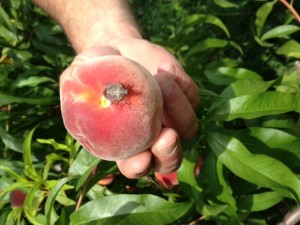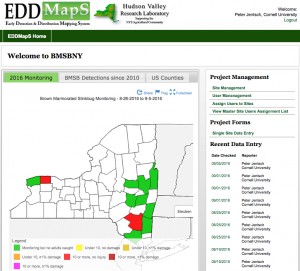Drought conditions will continue throughout the remainder of the week with daytime highs ranging from the mid 80’s to low 90’s. With no rain in sight, dry conditions will require significant irrigation to orchards as we move toward harvest of mid to late season varieties.
Native stink bugs including the green and brown, along with the invasive brown marmorated stink bug (BMSB) populations have been at historically low levels throughout most of NY state this season, the causes of which still remain unclear. Yet late season aggregations of BMSB adults have appeared in traps over the past week, placed by regional consultants and researchers in WNY and the mid-Hudson Valley.
The lures used in our Tedders traps utilize this aggregation phenomenon, a biological function of BMSB utilized to attract and monitor the insect. The stink bug utilizes the chemical to aggregate high numbers, often late in the season, to locate mates, draw the population to resources for food and gather together in overwintering sites.

We are beginning to find mostly BMSB adults and a late instar nymphs in agricultural ‘hot spots’. They have been noted along Ridge Road in Albion and along the northern ridge in Clintondale in Ulster County. These sites have exceeded threshold of 10 adults per week over the past week (Aug. 31st to Sept 6th). Given the present drought conditions we are likely to begin seeing these newly emerging adults seeking moisture in the form of irrigated apple foliage and fruit, giving rise to mid and late fall injury during fruit harvest.
It’s important to note that these populations are very scattered and in isolated pockets. In our observations today of 7 farms, only two orchards had populations above threshold. very few BMSB (3 adults) were observed in deciduous host trees including Tree of Heaven, Ailanthus altissma, while there were none found on apple where BMSB were absent from traps.
In tree fruit production effected by stink bug, both early and late season peach appear to be preferred over apple with pear somewhere between the two. In one southern Connecticut orchard carrying a light peach crop this season, over 50 adults were found in a Tedders trap during this past week. High numbers of BMSB were also observed in trees and crawling from picking buckets during harvest.
Scouting & Monitoring: BMSB is a perimeter pest, which tends to aggregate and feed along the orchard edge in highest numbers. Scout along the orchard block wooded edge utilizing a 1 BMSB adult per 100′ as a threshold for application. Or, monitor blocks with historic injury from stink bug using baited Tedders Traps with kill strips, applying a 10 trap per week threshold for applications to control the insect. Contact AgBio to order traps.
Management: In sites where traps exceed threshold:
Applications for management of BMSB should be made at the first available window using one of the most effective insecticides that will best fit your harvest schedule.

The list of the most effective insecticides for BMSB management is found above. NYS labeled insecticides effective for use against the BMSB are available in four major classes including pre-mix formulations. Danitol is likely to be the best choice during the latter part of the season as its short pre-harvest interval and efficacy is a good fit. It is not as effective as Bifenthrin, however, it’s a very good choice for management of BMSB in peach as it has a 3-day PHI, strong efficacy, especially as a knock down insecticide, and also works well against the native stink bugs.
New York’s Section 18 application for the use of products containing bifenthrin has recently been approved by the EPA to control brown marmorated stink bug (BMSB). This is a renewal by the EPA and NYS DEC of a ‘Section 18 Emergency/Crisis Exemption Approval’ use permit for the pyrethroid bifenthrin to control brown marmorated stink bug on apples, peaches, and nectarines this year. Comparative efficacy studies in the lab and field have shown bifenthrin to be one of the most effective insecticides available against BMSB for use in NY State. Although this is an important tool for management of BMSB, the residual against this pest is relatively short lived, requiring vigilance in trapping and scouting 4 days post application.
The regional application request was submitted to EPA from the mid-Atlantic states of DE, MD, NC, NJ, PA,VA, WV and NY state. Its use is limited to Columbia, Dutchess, Orange and Ulster Counties of NY.
Bifenthrin is one of the most effective insecticides for use against the brown marmorated stink bug (BMSB). Its use is limited to Columbia, Dutchess, Orange and Ulster Counties of NY. Upon determining the presence and trap threshold for BMSB in counties where the pest has caused injury to fruit in the past, applications of bifenthrin should be considered as the first step in managing the insect, taking into account the 30-day interval between applications. Consider a first application to be made along the orchard edge, bordering deciduous woodland and hedgerow or clusters of host trees such as catalpa, black locust, Tree of Heaven, maple, or ash. The need for a second application can be triggered as the insect is observed on fruit and/or captured in pheromone traps using 10 BMSB adult per trap per week as indicated by the EDDMaps.org site or trap presence on site.
Bifenthrin is a pyrethroid sold under the trade names of Brigade WSB (10% bifenthrin, EPA Reg. No. 279-3108, FMC Corp.), Bifenture EC (25% bifenthrin, EPA Reg. No. 70506-227), and Bifenture 10DF (10% bifenthrin, EPA Reg. No. 70506-227, United Phosphorus Inc.). Regardless of the product used, a maximum of 0.08 to 0.2 lb[AI]/acre/season will be allowed, with no more than 0.5 lb a.i./acre applied per year with multiple applications made at a minimum of 30 day intervals; a restricted entry interval (REI) of 12 hours and pre-harvest interval (PHI) of 14 days must be observed. When applying either of these materials for BMSB control on apples, peaches, or nectarines, growers must have possession of the Section 18 label. The 2016 labels will be posted as soon as they are made available.

Labels specific for the Section 18 Exemption for bifenthrin use in NY can be found here for 2016 reference.
Brigade WSB
Bifenture EC
Bifenture 10DF
Regardless of the product used, a maximum of 0.08 to 0.2 lb[AI]/acre/season will be allowed, with no more than 0.5 lb a.i./acre applied per year with multiple applications made at a minimum of 30 day intervals; a restricted entry interval (REI) of 12 hours and pre-harvest interval (PHI) of 14 days must be observed. When applying either of these materials for BMSB control on apples, peaches, or nectarines, growers must have possession of the Section 18 label.
BMSB Management: The brown marmorated stink bug is an arboreal insect, residing in woodland deciduous trees. Although the insect prefers an arboreal habitat, with woodland tree species providing nutritional and reproductive resources, in the Northeast it appears to move out of woodlands to orchards during periods of low relative humidity and the onset of drought conditions.
The use of pheromone baited Tedder’s traps will intercept the insect as it makes it way out of the woods and into agricultural crops, including apple and peach. A weekly trap capture of 10 adults / trap is presently being used as the action threshold for management. A single adult within the orchard perimeter rows bordering woodlands or a single apple damaged by stink bug can also be considered as viable action thresholds for BMSB.
Through cooperative efforts from NYSAES Geneva, County based CCE, the Eastern NY Commercial Horticultural Team and the Hudson Valley Research Lab have been monitoring 44 traps in 14 NY counties with data available on-demand, accessible on the Internet at EDDMaps.org. Upon determining the presence of BMSB in counties where the pest is at or above trap threshold and or has caused injury to fruit, applications of bifenthrin should be considered as the first application in managing the insect. The use of bifenthrin is preferred at this time due to its efficacy, a 30-day interval restriction between applications and a 14d PHI.
At trap threshold, during scouting observations of adults or at first fruit injury, consider a first application to be made along the orchard edge as a perimeter spray directed only at the crop. Apply to blocks along the deciduous woodland, hedgerow or clusters of host trees such as catalpa, black locust, Tree of Heaven, maple, cherry or ash. The need for a second application can be triggered as the insect is observed on fruit and/or captured in pheromone traps using 10 BMSB adult per trap per week as indicated by the EDDMaps.org site or farm trap presence on site.
The rational behind the use of perimeter management is based on two important facts. First, BMSB adults are not endemic as they do not reside or overwinter in the orchard. They will move from deciduous woodlands and or infested fields of vegetable crops initially into the orchard edge. Secondly, from historical orchard damage assessment, BMSB injury occurs within the first 90’ perimeter bordering wooded edge.
In early August, 2012, we observed BMSB developing a second generation. This was followed by movement into the orchard and increased feeding in red delicious beginning late August, with highest numbers of adults observed along the wooded edge of the farm. Across commodities, the highest damage levels from BMSB occur in Ag crops along the perimeter edge. Management along the orchard perimeter crop appears to be very effective and economical. It also preserves predatory mite late in the season when European red mite and two spotted spider mite tend to flare-up.
Last Word: One of the possibilities for this subtle rise in BMSB presence is that the low seasonal presence, caused by high mortality during the April 5-6th freeze events in deciduous host trees, gave rise to ‘pockets’ of BMSB that survived well in made-made structures. Isolated populations emerging from barns, storage facilities and warm garages created ‘suburban’ populations emerging near these buildings. Farms with structures supporting high number of overwintering adults had an environment more conducive to spring reproductive success. The development of a 1st generation gave rise to many more adults that we are now finding in our traps.


